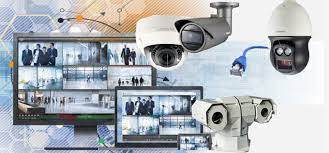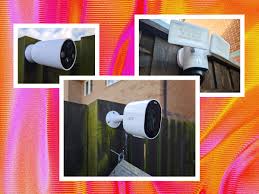Electronic Burglar Alarm: Securing Your Peace of Mind
In today’s fast-paced world, ensuring the safety and security of our homes and businesses has become a top priority. One effective way to protect our valuable assets and loved ones is by installing an electronic burglar alarm system. These advanced security systems act as a deterrent to potential intruders and provide round-the-clock monitoring, giving you peace of mind.
An electronic burglar alarm consists of various components that work together seamlessly to safeguard your premises. The central element is the control panel, which serves as the brain of the system. It receives signals from sensors placed strategically around your property and triggers an alarm when unauthorized activity is detected.
One of the key components of a burglar alarm system is the door and window sensors. These small devices are installed on entry points such as doors and windows, and they detect any unauthorized opening or tampering. When triggered, they send a signal to the control panel, which then activates the alarm.
Another essential component is motion detectors. These sensors use infrared technology to detect movement within a designated area. They are commonly installed in hallways, living rooms, or other areas where an intruder would likely pass through. If any suspicious movement is detected, the motion detectors immediately send a signal to the control panel for further action.
In addition to these primary components, modern burglar alarm systems often include other advanced features for enhanced security. These may include:
- Security cameras: CCTV cameras can be integrated into your burglar alarm system to provide visual surveillance footage in real-time. This allows you to monitor your property remotely and provides valuable evidence in case of any incidents.
- Remote access: With remote access capabilities, you can control and monitor your burglar alarm system from anywhere using your smartphone or computer. This feature enables you to arm or disarm the system remotely or receive instant notifications when an alarm is triggered.
- Panic buttons: Panic buttons are installed in strategic locations within your premises, allowing you to quickly summon help in case of an emergency. With just a press of a button, the alarm is triggered, alerting the monitoring station or relevant authorities.
- Integration with other security systems: Burglar alarm systems can be integrated with other security systems such as fire alarms and access control systems. This integration ensures comprehensive protection and allows for centralized management of all security measures.
Installing an electronic burglar alarm system not only protects your property from theft and vandalism but also acts as a deterrent to potential criminals. Studies have shown that properties equipped with visible security systems are less likely to be targeted by burglars.
Moreover, having a burglar alarm system can also result in lower insurance premiums as insurance companies often offer discounts for properties with robust security measures in place.
When choosing an electronic burglar alarm system, it is essential to consider your specific needs and budget. Consulting with a professional security provider can help you determine the most suitable system for your property and ensure proper installation and maintenance.
In conclusion, investing in an electronic burglar alarm system is a proactive step towards securing your peace of mind. These advanced security systems provide effective protection against unauthorized access and intrusions while offering additional features for enhanced convenience and control. With 24/7 monitoring and instant alerts, you can rest assured knowing that your home or business is well-protected even when you’re away.
Frequently Asked Questions About Electronic Burglar Alarms
- What is an electronic burglar alarm?
- How does an electronic burglar alarm work?
- What are the different types of electronic burglar alarms?
- How do I install an electronic burglar alarm?
- What are the benefits of having an electronic burglar alarm?
- How much does it cost to get an electronic burglar alarm installed?
What is an electronic burglar alarm?
An electronic burglar alarm is a security system designed to detect and deter unauthorized entry or intrusion into a property. It consists of various electronic components that work together to monitor and protect the premises from potential burglars or intruders.
The main components of an electronic burglar alarm system include:
- Control Panel: This serves as the central processing unit of the system. It receives signals from sensors and activates the alarm when triggered.
- Sensors: These are devices that detect specific events or activities and send signals to the control panel. Common types of sensors used in burglar alarms include door/window sensors, motion detectors, glass break detectors, and vibration sensors.
- Alarm Siren: When an unauthorized entry is detected by the sensors, the control panel activates the alarm siren to alert occupants or neighbors about the potential intrusion.
- Keypad/Control Interface: This allows users to arm or disarm the system using a unique access code or key fob. It also provides visual indicators and audible feedback for system status.
- Monitoring System: Some burglar alarm systems are connected to a monitoring service, which receives alerts from the control panel when an alarm is triggered. The monitoring service can then contact appropriate authorities or take necessary action based on predefined instructions.
- Optional Features: Depending on the specific system, additional features may be included such as security cameras for video surveillance, remote access capabilities through smartphones or computers, panic buttons for immediate assistance, and integration with other security systems like fire alarms or access control systems.
The purpose of an electronic burglar alarm is twofold: deterrence and detection. The visible presence of an alarm system acts as a deterrent to potential intruders who may be discouraged from attempting a break-in in fear of setting off an alarm and attracting attention. In case of an actual intrusion, the sensors within the system detect unauthorized activity (such as opening doors/windows or movement) and trigger the alarm, alerting occupants or authorities to take appropriate action.
Overall, an electronic burglar alarm provides peace of mind by enhancing the security of a property and reducing the risk of burglary or unauthorized access. It serves as a proactive measure to protect homes, businesses, and valuable assets while deterring potential criminals from targeting the premises.
How does an electronic burglar alarm work?
An electronic burglar alarm system works by utilizing a combination of sensors, control panels, and communication devices to detect unauthorized entry or suspicious activity and trigger an alarm. Here’s a breakdown of how it typically operates:
Sensors: The system includes various sensors strategically placed throughout the premises. These sensors can be in the form of door/window contacts, motion detectors, glass break detectors, or other specialized devices. Each sensor is designed to detect specific types of intrusions or unauthorized access.
Control Panel: The control panel serves as the central hub of the burglar alarm system. It receives signals from the sensors and processes the information to determine if there is a potential threat. The control panel is usually located in a secure area and connects to power sources and communication devices.
Arming/Disarming: Before leaving the premises or going to bed, users can arm the system using a keypad or remote control device. Arming activates all the installed sensors, ensuring that any detected intrusion triggers an alarm response. Disarming involves deactivating the system when authorized individuals enter using a unique code or remote control.
Detection: When armed, the sensors continuously monitor their respective areas for any unusual activity. For example, door/window contacts detect if someone tries to open a door or window without authorization, while motion detectors sense movement within their range.
Alarm Triggering: If a sensor detects unauthorized entry or suspicious activity, it sends a signal to the control panel indicating an alarm event. The control panel then evaluates whether it meets pre-defined criteria for triggering an alarm (e.g., specific sensor combinations). If criteria are met, it initiates an alarm response.
Alarm Response: Once triggered, the burglar alarm system responds by activating various actions depending on its configuration and settings:
– Audible Alarm: The system may activate sirens or loud alarms within and/or outside the premises to alert occupants and deter intruders.
– Visual Indicators: Some systems incorporate flashing lights or strobes to attract attention and indicate an alarm event.
– Notification: The system can send notifications to a monitoring station, security personnel, or the property owner via phone calls, SMS messages, or internet-connected devices.
– Remote Monitoring: Advanced systems may include features that allow remote monitoring and control, enabling users to access real-time information about their security system through mobile apps or web interfaces.
Disarming and Resetting: Once the threat has been addressed or determined to be a false alarm, authorized individuals can disarm the system using their code or remote control. This stops the audible alarms and resets the system for normal operation.
It’s important to note that electronic burglar alarm systems can vary in complexity and features depending on the specific requirements of the premises and user preferences. Professional installation and regular maintenance are crucial for ensuring optimal performance and reliability.
What are the different types of electronic burglar alarms?
There are several types of electronic burglar alarms available in the market today, each designed to cater to different security needs. Here are some common types of electronic burglar alarms:
- Wired Burglar Alarms: These systems consist of sensors and control panels that are connected through physical wiring. Wired burglar alarms are known for their reliability and stability, as they do not rely on wireless signals. However, installation can be more complex and time-consuming due to the need for wiring throughout the premises.
- Wireless Burglar Alarms: Wireless burglar alarm systems use radio frequency signals to communicate between sensors and control panels. They offer easy installation without the need for extensive wiring, making them a popular choice for both homeowners and businesses. Wireless systems are flexible and can be easily expanded or reconfigured as needed.
- Hybrid Burglar Alarms: Hybrid systems combine both wired and wireless components, offering the advantages of both types. This allows for greater flexibility during installation while maintaining the stability of wired connections where necessary.
- Monitored Alarms: Monitored burglar alarm systems provide an additional layer of security by connecting to a monitoring center or security company. When an alarm is triggered, it sends a signal to the monitoring center, which then takes appropriate action such as contacting the property owner or dispatching authorities if necessary.
- Unmonitored Alarms: Unmonitored burglar alarms activate an audible siren or sound when triggered but do not connect to a monitoring center or security company directly. The responsibility falls on the property owner or nearby individuals to respond to the alarm.
- Smart Home Security Systems: These advanced burglar alarm systems integrate with smart home technology, allowing you to control and monitor your security system remotely using your smartphone or other connected devices. Smart home security systems often include features such as mobile alerts, remote arming/disarming, and integration with other smart devices in your home.
- Pet-Friendly Alarms: Pet-friendly burglar alarms are designed to minimize false alarms caused by pets. These systems use specialized sensors that can differentiate between human movement and the movement of smaller animals, reducing the chances of unnecessary alarm activations.
- Perimeter Alarms: Perimeter burglar alarms focus on securing the outer boundaries of a property. They use sensors such as infrared beams or motion detectors to detect any unauthorized entry attempts into the premises.
When selecting an electronic burglar alarm system, it is important to consider factors such as the size and layout of your property, specific security requirements, budget, and personal preferences. Consulting with a professional security provider can help you determine the most suitable type of burglar alarm system for your needs and ensure proper installation and configuration.
How do I install an electronic burglar alarm?
Installing an electronic burglar alarm system requires careful planning and attention to detail. While it is recommended to consult with a professional security provider for a seamless installation, here are some general steps to help you understand the process:
- Assess your security needs: Determine the areas of your property that require protection and identify potential entry points for intruders. This will help you determine the number and placement of sensors, cameras, and other components.
- Choose the right system: Select a burglar alarm system that meets your specific requirements. Consider factors such as the size of your property, desired features (e.g., remote access, integration with other systems), and budget.
- Gather necessary equipment: Purchase the burglar alarm system kit or individual components based on your chosen system. Ensure that you have all the necessary sensors, control panel, wiring, power supply, and any additional accessories required for installation.
- Plan sensor placement: Strategically place door/window sensors and motion detectors in key areas of your property. Install sensors on all accessible doors and windows, including ground-level and basement entry points. Position motion detectors in areas where they can cover maximum space without being obstructed by furniture or other objects.
- Mount control panel: Find a central location within your property to mount the control panel. It should be easily accessible but not easily visible or reachable by intruders.
- Connect wiring: Follow the manufacturer’s instructions to connect wiring between sensors, control panel, power supply, and any other components as required.
- Test the system: Once everything is connected, test each sensor and component to ensure they are functioning correctly. Activate each sensor individually to verify if it triggers an alert on the control panel.
- Configure settings: Set up user codes and customize settings such as entry/exit delay times for arming/disarming the system according to your preferences.
- Install additional features (if applicable): If you have security cameras or other integrated systems, follow the manufacturer’s instructions to install and configure them accordingly.
- Secure wiring and conceal components: Conceal wiring within walls or use wire covers to prevent tampering. Ensure that all components are securely mounted and not easily accessible to intruders.
- Sign up for monitoring service (optional): If you choose to have professional monitoring, contact a reputable security company to subscribe to their monitoring service. They will guide you through the process of connecting your system to their monitoring station.
Remember, these steps provide a general overview of the installation process, but it is crucial to refer to the specific instructions provided by the manufacturer for your chosen burglar alarm system. If you are unsure about any aspect of the installation, it is advisable to seek assistance from a professional security provider who can ensure proper installation and functionality of your electronic burglar alarm system.
What are the benefits of having an electronic burglar alarm?
Having an electronic burglar alarm system offers numerous benefits that contribute to the overall security and peace of mind. Here are some key advantages of installing such a system:
- Deterrence: The presence of a visible burglar alarm acts as a strong deterrent to potential intruders. Criminals are less likely to target properties with robust security systems in place, knowing that their chances of being caught or detected are significantly higher.
- Intrusion Detection: Electronic burglar alarms are equipped with sensors that detect unauthorized entry or tampering, such as door and window sensors and motion detectors. These sensors immediately trigger an alarm when they detect suspicious activity, alerting you and potentially scaring off the intruder.
- 24/7 Monitoring: Burglar alarm systems often come with professional monitoring services. This means that trained security personnel are constantly monitoring your property for any signs of intrusion or emergency situations. In case of an alarm activation, the monitoring station can quickly dispatch authorities or notify you accordingly.
- Quick Response: With a monitored burglar alarm system, emergency response times can be significantly reduced. When an alarm is triggered, the monitoring station can promptly contact the relevant authorities, such as the police or fire department, ensuring swift response and potentially minimizing damage or loss.
- Remote Access and Control: Many modern burglar alarm systems offer remote access capabilities through mobile apps or online platforms. This allows you to control and monitor your system from anywhere at any time using your smartphone or computer. You can arm or disarm the system remotely, receive real-time notifications, and even view live surveillance footage if integrated with cameras.
- Integration with Other Security Systems: Electronic burglar alarms can be seamlessly integrated with other security systems like CCTV cameras, access control systems, or fire alarms. This integration provides comprehensive protection for your property while allowing centralized management and control of all security measures.
- Insurance Benefits: Having an electronic burglar alarm system installed can often lead to reduced insurance premiums. Insurance companies recognize the added security and lower risk of theft or damage, offering discounts to properties with robust security measures in place.
- Peace of Mind: Perhaps the most significant benefit of having an electronic burglar alarm system is the peace of mind it brings. Knowing that your property is being monitored and protected 24/7 provides a sense of security for you, your loved ones, and your valuable assets.
Overall, investing in an electronic burglar alarm system not only helps prevent break-ins but also enhances the overall safety and security of your property. It offers a proactive approach to deterrence, detection, and response, ensuring that you can rest easy knowing that your home or business is well-protected.
How much does it cost to get an electronic burglar alarm installed?
The cost of installing an electronic burglar alarm can vary greatly depending on the type of system, the complexity of the installation, and other factors. Generally speaking, a basic wired system can cost anywhere from $500-$2,000 to install, while a wireless system can cost around $200-$1,000. Professional monitoring services may also be available for an additional fee.




